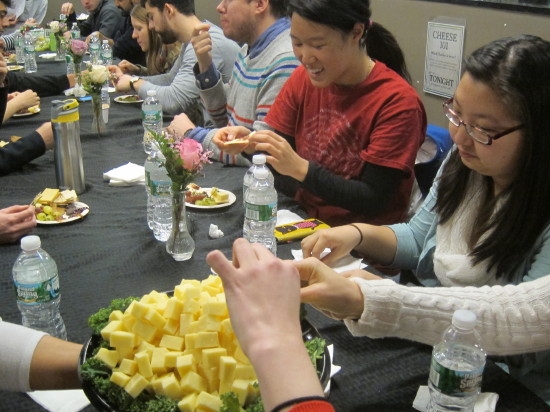
Allan Appel Photo
Amateur cheeseologist Vikram Dhawan sampled a two-year-old Grafton to answer an aromatic question.

Some unsampled Cheddars.
Dhawan was one of 47 people who braved the biting cold Wednesday night to attend Cheese 101, the latest installment of a free hour-long fun “course” in cheese-ology conducted at Elm City Market at State and Chapel streets. The course required visitors to compare and to pair four Cheddars chosen by Elm City Market’s cheesemonger-in-chief Rebekah Basquette, and to weigh in on which variety of cheddar tasted best.
Of those 47 at least half were, like Dhawan, Yale students who had heard about the event from Elm City Market’s Facebook page or other social media outlets; you’d think the university wasn’t feeding them properly.

Chief cheesemonger Basquette came to the market after five years with Whole Foods.
At the Yale dining facilities they likely were not being asked, as Basquette was doing, to compare the merits of Grafton Village Two-Year Old Cheddar, Grafton Smoked Cheddar, Abbey Goat Cheddar, and, finally, a double Gloucester Cheddar with chives and onions from the Cotswold region. In short it was the battle of two Vermont Cheddars against two English Cheddars.
Those are just four of the 14 Cheddars the store carries, said Basquette. The cheese course,which is conducted the last Wednesday of each month, is one of six or seven events a week at the store, said Elm CIty Market marketing staffer Alexa Apotria. It has been offered under both the former and current management because of its popularity.
Of all the products in the store, people ask the most questions about cheese, Apotria reported as she arranged crackers, assembled boxes of toothpicks, and made final preparations for the event.
The tasters took off their coats, loaded plates with the pairings — chocolate chip cookies, dark chocolate squares, salty and plain crackers, and grapes — and lifted their toothpicks.
The Cheddar Facts, Please

The four Cheddars prepare for combat.
Basquette first delivered a brief lecture that included some basic Cheddar facts: The cheese was first recorded having been made in the town of Cheddar, in England in the 12th century; almost all Cheddars come from cows, with tonight’s goat Cheddar a surprise;Cheddar’s often orange‑y color comes from annatto, a natural plant dye that hails from the sub-tropics; and the capital of Cheddar production in the U.S.A. is … yes, Wisconsin, where it was first produced in the 1800s.
So much for the learning. Now for the eating and the battle of the Vermont cheeses versus the English.
Dhawan yummed as he tasted the two-year-old Grafton. He pronounced it “dense, sharp. I’ll eat it in small bites; it’s a lot to take in.”
Basquette suggested to him and the others that it would go well with dates, melons, and chutney.

The pairings are readied.
Then the smoked Grafton had its turn on the tasters’ palates. Dhawan found it “chewier, less sharp, although still dense.”
Basquette explained that he was probably responding to the greater dryness of the cheese, the result of the smoking.
Third up was the new kid on the block at Elm City Market’s cheese department: an Abbey Cheddar, from England, goat-based and even suitable for vegetarians, she said, because the rennet, the enzyme used to produce the cheese, is vegetable-based.
While most Cheddars are from cows, this goat product tasted decidedly different to Dhawan. He pronounced it “flakier, more flavorful.” He said he did not know when he tasted that he had shifted animals, but he agreed that the difference was significant enough for that to make sense to him.
Finally, the only deeply orange Cheddar was offered. Basquette said the Cotswold, a double Gloucestershire Cheddar was her personal favorite. Because it contains chives and onions, “it’s great on mashed potatoes,” she suggested, “and melts beautifully if you put it on your cheeseburger.”

Sammy Bensinger (pictured), a Yale sophomore sitting beside Dhawan, immediately called the Cotswold her favorite. She termed it “the most flavorful. I don’t even want anything spread on it or with it,” she added.
Dhawan disagreed. “I need to have something with this, something bland, like a cracker,” he said.
At the end of the session, a vote was taken for the favorite of the four Cheddars. The Grafton two-year old garnered four votes; the smoked Grafton and the Cotswold received seven each; and the winner, by a morsel, was the Abbey goat Cheddar, with eight votes. That doesn’t add up to the 47 tasters, but most people were still too busy eating to vote.

Rijul Gupta (pictured), who is taking off time between his junior and senior year at Yale to try to launch a social media start-up, said he appreciated all the free and tasty cheese. The flavors were new to him, even though his mother makes Indian food, and along with it, produces her own cheese. He said he’s a cheese lover but can afford it only in larger stores, where the Oregon-based Tillamook is his choice.
“I was looking to branch out,” and he called what he was offered adventurous. He voted for the Grafton two-year-old Cheddar.

The next session is in February and is titled “Battle of the Blues,” said Basquette.
The turnout Wednesday was so impressive, next month’s event will be moved to the second floor of the market, Apotria said.